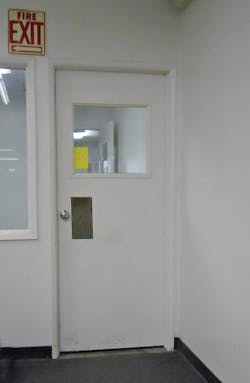With the advent of adjustable spring closing force, choosing the “right” surface-mounted door closer for a specific door has become much easier. For example, a 3’0” by 7’0” interior door is a very common size for many commercial applications. Checking a closer catalog will usually recommend a number two or number three sized door closer.
However, choosing a door closer is determined by more than just the door width and height. The weight of a door is the most critical consideration, as the heavier the door the more force required to close the door.
Using a door closer with adjustable spring closing force can eliminate most of the decision making process. For most standard size and construction doors, whether they are installed for interior or exterior applications, an adjustable spring closing force door closer can be adjusted to operate.
Arrow Lock and Door Hardware has introduced their DC500 Series heavy-duty door closers, designed to meet the requirements of ANSI/BHMA A156.4, Grade 1 and the Standard UL 10C for self-closing, surface-mounted type without hold-open feature. DC500 Series door closers meet ANSI A117.1 requirements for ADA barrier-free accessibility of five pounds maximum opening force depending upon the application.
Arrow DC500 Series door closers have a cast iron body, with a hardened steel rack and pinion, and high tensile strength steel springs. There are three size adjustable models: the DC516, DC514 and the DC525.
The DC516 has an adjustable spring for sizes 1 through 6. This door closer is designed to meet most door closer applications, as it can be adjusted to provide sufficient closing force for interior and many exterior door applications having a variety of on-site conditions.
The DC514 has an adjustable spring for sizes 1 through 4. This door closer is designed for light through medium weight interior doors and light weight exterior doors. The DC514 can meet the five pound handicapped requirements.
The DC525 has adjustable spring for sizes 2 through 5. DC500 Series door closers have separate adjustment valves for sweep and latch, as well as backcheck.
These non-handed door closers are specifically packaged for mounting regular (standard), top jamb, and parallel arm when equipped with a standard arm or a standard hold open arm. The regular arm application has the closer body mounted on the hinge (pull) side of the door. The forearm is mounted to the frame face by a mounting shoe. The arm projects at a 90-degree angle away from the door. The regular arm application is used when there is no concern about the arm extending perpendicular from the door. The regular arm mount closer is more power efficient than either the parallel arm or top jamb mount.
The top jamb is a method for mounting the closer if the door has a narrow mounting area. For example, the top jamb method can be used for aluminum glass door with a narrow rail or a door with a large glass panel. The closer body is mounted to the frame face above the door, opposite the hinge (push) side of the door. The forearm is mounted to the door. The top jamb mount is more power efficient than the parallel arm application.
The parallel arm method is for mounting the closer having the arm parallel to the door. This mount style can limit vandalism by having the arm in close proximity to the door face, improving the overall aesthetics. The closer body is mounted on the door opposite the hinge (push) side. A parallel arm bracket mounts the forearm to the underside of the frame. The parallel arm mount is probably the least power efficient mounting application.
For this installation, I installed the Arrow DC525-1, an adjustable size 2-5 door closer with the standard Hold Open arm and Parallel Arm bracket onto an interior wooden door separating the manufacturing area from the offices. The hollow core door has a glass panel. The outswing door has a maximum opening of less than 90 degrees.
Important: For parallel arm installation, the Back Check selector valve must be closed (rotated clockwise to all the way in) before installation.
I used the included 1-3/4” through-bolts (sex nuts) to secure the door closer body using parallel arm mounting. I installed the optional friction hold open arm to accommodate occasional cart traffic.
I followed the provided instructions for the parallel arm installation, mounting the closer onto the push side of the door so the closer was visible only from the manufacturing side.
Four holes were located for the closer body onto the door and five holes were located for the parallel arm bracket onto the underside of the frame. The four closer body holes are drilled from the interior side beginning with a 1/8” diameter pilot bit. When I was certain the holes were in the proper positions on both sides of the door, I enlarged the four holes using a 9/32” diameter bit, large enough to accommodate the ¼ - 20 machine screws.
Once the holes have been drilled, I enlarged the four holes on the door face opposite the door closer using an 11/32” diameter bit. The smaller size bit provides a tighter fit for the through-bolts when installing the device onto a wood or particle board skin door. After installing the through-bolts, I mounted the closer body, securing the screws using thread locker. The thread locker was used to prevent the screws from unscrewing.
After marking the holes for the parallel arm bracket, I drilled 1/8” diameter pilot holes to ensure the wood screws would be centered within the parallel arm bracket holes. With the parallel arm bracket mounted, the next step is to attach the arm.
For this installation, a friction hold open arm was installed. The friction hold open arm works using a varying sloping thickness type of spacer that starts to contact the rotating arm surface as the door is opened. As the door opens further before completing the opening swing, the arm becomes trapped. The hold open arm keeps the door open as there is not enough closing force to enable the door to close. The amount of resistance is adjusted by turning the bolt. Tighter increases pressure and looser decreases pressure.
Arrow friction hold open arms come from the factory handed for a left hand (LH) door. To reverse the handing of the arm, the forearm screw is removed and the forearm is slid out, flipped over and inserted back into the sleeve. The forearm screw is re-installed in the same opening with the forearm at the same length.
Note: For a right hand door, the bolt is on the top of the arm when installed onto the parallel arm bracket.
The next step is to pre-load the door closer. This provides additional closing force by rotating the spindle to increase compression of the spring. Pre-loading this door closer requires rotating the spring approximately 30 degrees. Without pre-load, the door closer would not have sufficient closing force to close and latch the door.
Once the spindle is in the pre-load position, mount the arm assembly. Just thread the mounting screw in position to secure the arm onto the spindle. Secure the forearm onto the parallel arm bracket.
Open the door and allow the door closer to close and latch the door. Repeat this several times. If the closer does not close and latch the door, increase the spring force. If there is too much pressure, decrease the spring pressure. The installation sheet has spring force recommendations according to door width.
Adjust the sweep and the latch valve to have a smooth, quiet operation.
Adjust the backcheck to ensure the door does not slam into the wall as it is being opened. Remember the door closer backcheck is not designed to provide a physical stop. Whenever possible, use a dedicated door stop to prevent opening damage.
When the door closer is in adjustment, install the plastic cover by first removing the proper knockout. Install the cover using the provided two hex head screws.
Arrow DC500 Series door closers come with 1-3/4" through-bolts and a full plastic cover. Four configurations of drop plates, two standard and two heavy-duty arms, are available. The DC500 Series door closers have a 10-year limited warranty. They are available in Aluminum (689) and Dark bronze (690) finishes.
For more information, contact your local locksmith distributor or Arrow Lock & Door Hardware, P.O. Box 3075, Salem, VA 24153. Telephone: 800-839-3157. Web Site: www.arrowlock.com.
To read additional Locksmith Ledger articles on door closers, visit http://tinyurl.com/closer1011






